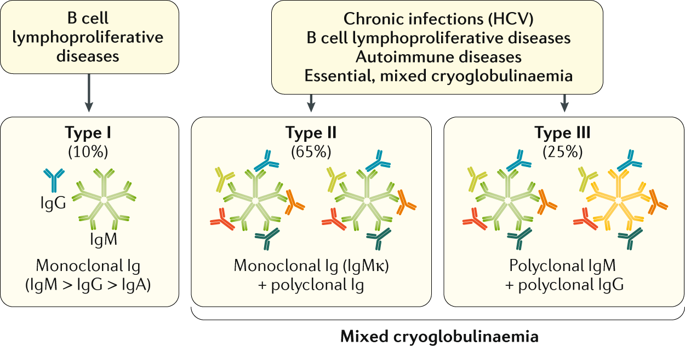当前位置:
X-MOL 学术
›
Nat. Rev. Dis. Primers
›
论文详情
Our official English website, www.x-mol.net, welcomes your
feedback! (Note: you will need to create a separate account there.)
Cryoglobulinaemia.
Nature Reviews Disease Primers ( IF 76.9 ) Pub Date : 2018-Aug-02 , DOI: 10.1038/s41572-018-0009-4
Dario Roccatello , David Saadoun , Manuel Ramos-Casals , Athanasios G. Tzioufas , Fernando C. Fervenza , Patrice Cacoub , Anna Linda Zignego , Clodoveo Ferri
Nature Reviews Disease Primers ( IF 76.9 ) Pub Date : 2018-Aug-02 , DOI: 10.1038/s41572-018-0009-4
Dario Roccatello , David Saadoun , Manuel Ramos-Casals , Athanasios G. Tzioufas , Fernando C. Fervenza , Patrice Cacoub , Anna Linda Zignego , Clodoveo Ferri

|
Cryoglobulinaemia refers to the serum presence of cryoglobulins, which are defined as immunoglobulins that precipitate at temperatures <37 °C. Type I cryoglobulinaemia consists of only one isotype or subclass of monoclonal immunoglobulin, whereas type II and type III are classified as mixed cryoglobulinaemia because they include immunoglobulin G (IgG) and IgM. Many lymphoproliferative, infectious and autoimmune disorders have been associated with mixed cryoglobulinaemia; however, hepatitis C virus (HCV) is the aetiologic agent in most patients. The underlying mechanism of the disorder is B cell lymphoproliferation and autoantibody production. Mixed cryoglobulinaemia can cause systemic vasculitis, with manifestations ranging from purpura, arthralgia and weakness to more serious lesions with skin ulcers, neurological and renal involvement. This Primer focuses on mixed cryoglobulinaemia, which has a variable course and a prognosis that is primarily influenced by vasculitis-associated multiorgan damage. In addition, the underlying associated disease in itself may cause considerable mortality and morbidity. Treatment of cryoglobulinaemic vasculitis should be modulated according to the underlying associated disease and the severity of organ involvement and relies on antiviral treatment (for HCV infection), immunosuppression and immunotherapy, particularly anti-CD20 B cell depletion therapies.
中文翻译:

低温球蛋白血症。
低温球蛋白血症是指血清冷球蛋白的存在,冷球蛋白定义为在<37°C的温度下沉淀的免疫球蛋白。I型冰球蛋白血症仅由一种单克隆免疫球蛋白的同种型或亚类组成,而II型和III型则被归类为混合性冰球蛋白血症,因为它们包括免疫球蛋白G(IgG)和IgM。许多淋巴增生性,感染性和自身免疫性疾病已与混合性冰球蛋白血症相关。但是,丙型肝炎病毒(HCV)是大多数患者的病因。该疾病的潜在机制是B细胞淋巴增殖和自身抗体产生。混合性冷球蛋白血症可导致全身性血管炎,表现形式从紫癜,关节痛和虚弱到更严重的皮肤溃疡,神经系统和肾脏受累病变。该入门指南重点研究混合性冰球蛋白血症,其病程可变,预后主要受血管炎相关的多器官损伤的影响。另外,潜在的相关疾病本身可能引起相当大的死亡率和发病率。应当根据潜在的相关疾病和器官受累的严重程度来调整冷冻球蛋白性血管炎的治疗,并依靠抗病毒治疗(用于HCV感染),免疫抑制和免疫疗法,尤其是抗CD20 B细胞耗竭疗法。
更新日期:2019-01-26
中文翻译:

低温球蛋白血症。
低温球蛋白血症是指血清冷球蛋白的存在,冷球蛋白定义为在<37°C的温度下沉淀的免疫球蛋白。I型冰球蛋白血症仅由一种单克隆免疫球蛋白的同种型或亚类组成,而II型和III型则被归类为混合性冰球蛋白血症,因为它们包括免疫球蛋白G(IgG)和IgM。许多淋巴增生性,感染性和自身免疫性疾病已与混合性冰球蛋白血症相关。但是,丙型肝炎病毒(HCV)是大多数患者的病因。该疾病的潜在机制是B细胞淋巴增殖和自身抗体产生。混合性冷球蛋白血症可导致全身性血管炎,表现形式从紫癜,关节痛和虚弱到更严重的皮肤溃疡,神经系统和肾脏受累病变。该入门指南重点研究混合性冰球蛋白血症,其病程可变,预后主要受血管炎相关的多器官损伤的影响。另外,潜在的相关疾病本身可能引起相当大的死亡率和发病率。应当根据潜在的相关疾病和器官受累的严重程度来调整冷冻球蛋白性血管炎的治疗,并依靠抗病毒治疗(用于HCV感染),免疫抑制和免疫疗法,尤其是抗CD20 B细胞耗竭疗法。































 京公网安备 11010802027423号
京公网安备 11010802027423号